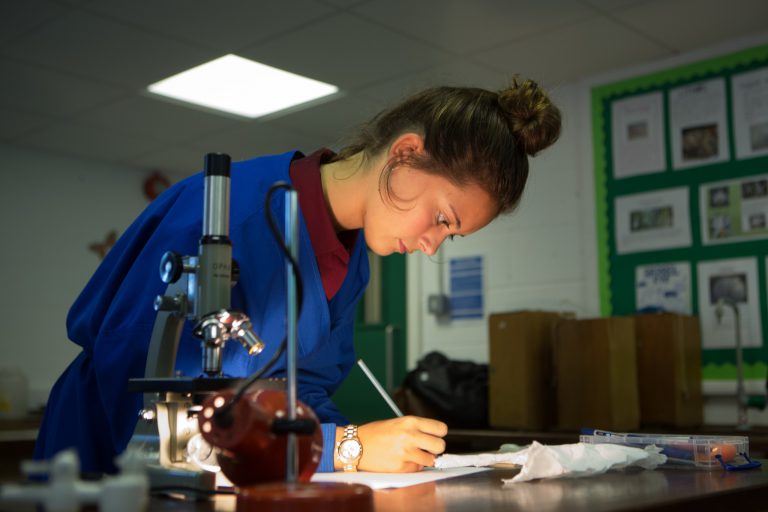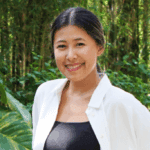
Recent figures reveal an expanding divide between the further education subjects selected by boys and girls. While girls tend to dominate arts and the health sciences, such as psychology and biology, boys are outnumbering girls by as many as eight to one in subjects like maths and computer science.
In spite of this, results for 2015 demonstrate that young women consistently outperform their male counterparts in STEM subjects at GCSE Level, but considering that women make up just 8.2 percent of Engineering professionals in the UK, and only one in ten, or 10.2 percent, of UK STEM management are female, it is clear their academic success is not translating to the professional sphere.
Why? Because young women lack confidence in their scientific capabilities.

It would seem this is a problem that starts early on in education, since even girls who do very well at GCSE Maths, for example, are far less likely than boys to continue Maths at A Level. In 2015, only an additional 99 girls studied Further Maths at A Level than they did the previous year, and it would seem this trend infects most other aspects of STEM; Physics in particular.
Figures demonstrate that some 80 percent of girls who achieve an A* in Physics at GCSE do not continue it to A Level, and in 2015, A Level Physics in the UK boasted just 75 more female students than it did in 2014. The subject is just one example of a scientific field in desperate need of the capable female perspective. It is one of the great imbalances of the modern education system.
Learning how things work, or rather studying physics, literally changes the way we think, enabling us to perform more complex cognitive tasks quickly and more efficiently. In this way, all STEM subjects are mentally nutritious, forcing us to see the world in an entirely new perspective and instilling in us a scientific mind-set that asks us to question everything we see: we wonder why? And we want to know how?
In a study by Carnegie Mellon University, researchers sought to identify which parts of the brain are stimulated as we uncover how things work. In order to achieve this, participants were taught the science behind several everyday items, including weighing scales, a fire extinguisher and a trumpet. Using data from fMRI scans, scientists were then able to track changes in thought patterns at different stages of the learning process.

After learning some of the science behind the object, participants were asked to think about the item while scientists’ tracked cerebral activity as their understanding developed. Using state-of-the-art technology, they were able to produce a ‘snapshot’ of the brain at a particular moment, allowing them to note changes and therefore measure the extent to which a person understood a particular idea or concept.
In short, the researchers found that knowing what things do and how they actually work are two entirely different things, and understanding the latter opens up all kinds of possibilities within the human mind. That’s what many of the best and brightest female students are missing out on.
So is there a viable solution for the male-female STEM education imbalance?
There is strong evidence to suggest that girls in single sex schools fare much better in this regard. Figures show that when boys are taken out of the classroom, female STEM figures dramatically improve: single-sex state schools send 2.5 times more girls on to study physics at A Level than co-education state schools.
“Girls and boys learn in different ways, so in a learning environment it makes sense to give each what they need at each varying stage of development,” says Antonia Beary, Headmistress of Mayfield School, an independent day and boarding school for girls in East Sussex, in the UK. “Girls from single-sex schools like Mayfield are far more likely to opt to study STEM subjects than their peers at co-educational schools.”

Many critics believe that a societal bias deeming girls unable to cope with scientific concepts prevents them from unleashing their full potential – and the UK’s professional STEM sector suffers as a result.
“Free from gender stereotyping, our girls enjoy not just equal opportunities, but all the opportunities,” adds Beary. “We have the expertise to adapt our teaching methods; to contextualise the curriculum with the world around us, in ways that inspire and capture the girls’ interest. We find more relevant ways to present scientific principles, and relate what is taught in the classroom to everyday life.”
And with this firmly ingrained, positive mentality, it would seem that Mayfield is doing things right. There are so many large and influential companies desperately seeking the young, female, scientific mind to add diversity and perspective to a workplace saturated with males. Furthermore, there is no reason why a solid education in the arts and sciences can’t go hand in hand.
“It is a myth that the sciences and the arts are mutually exclusive. To be successful as a scientist you need to be creative, and to be successful as an artist, you have to have the discipline, logic and focus that is usually associated with the scientific,” says Beary.
“Schools must encourage their pupils to be creative in all that they do. Rather than be influenced by gender stereotypes, they are encouraged to be themselves, and to be the best that they can be. Consequently, the next generation of girls will grow into mature, independent, confident and well-informed individuals ready to make their mark on the world.”
The subjects chosen by Mayfield girls are testament to the institution’s success at providing a gender-neutral education. These young women break free from societal assumptions to excel in the fields of Physics, Maths and Chemistry. Science is not reserved for the masculine mind; it is universal, and it is our duty as parents, peers and educators to promote it as such.
______________________

Mayfield School is a leading Catholic independent boarding and day school for girls aged 11-18, set in the beautiful Sussex countryside. Year after year, the School boasts outstanding academic results along with a diverse array of extra-curricular activities, exemplary pastoral care, and above all else, extremely happy students.
The School’s latest ISI inspection report labelled the quality of education provided at Mayfield as ‘Outstanding’, while Country Life magazine described Mayfield as “one of the finest schools in the land”.







